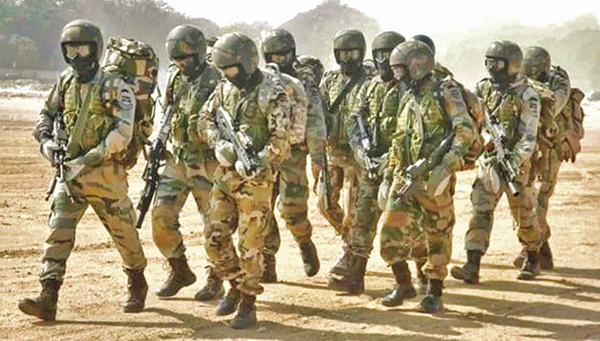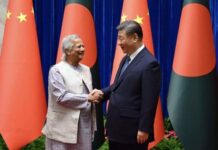Special Frontier Force in the Limelight
On 31 August, a statement from the Army said that on the night of August 29-30, “PLA troops violated the previous consensus arrived at during military and diplomatic engagements…and carried out provocative military movements to change the status quo.” However, the Indian troops “pre-empted this PLA activity on the Southern Bank of Pangong Tso Lake, undertook measures to strengthen our positions and thwart Chinese intentions to unilaterally change facts on ground.”
A few hours later, the social media was abuzz with news that a Tibetan officer had died. Company Leader Nyima Tenzin lost his life on a landmine in the theatre of operations.
This news turned the spotlight on the Special Frontier Force (SFF) and its predominantly Tibetan soldiers. The deployment of the SFF emerged as a source of pride for India’s Tibetan community. A video from 4 September showed Tibetans in Shimla gathering, singing and tying their traditional khatas (white scarves) to a departing convoy as they waved goodbye to SFF personnel headed for the Ladakh front.
ALSO READ: INDIA-CHINA: Indian Troops Occupy Key Heights North of Pangong Tso
The SFF serves in the Directorate General of Security (DGS) – a wing of India’s external intelligence agency R&AW. With help from the Aviation Research Centre (ARC) – the air wing of the DGS and superior reconnaissance capabilities, the Tibetan refugees-dominated SFF can conduct covert operations behind Chinese enemy lines at will.
The SFF has mostly operated in the shadows since its creation in 1962. When Tibetan resistance fighters began crossing over into India with the 1956 uprising. More followed in the wake of the failed uprising three years later and the Dalai Lama’s exile to India. Most of the resistance fighters were from the Kham region of eastern Tibet, which was one of the major sites of rebellion against the Chinese.
Earlier they were used in a covert manner, but now, it’s against China. It’s a clear message, even to the people in Tibet.
Raising of the SFF
The fighters did not lack passion but needed weapons and training. The CIA was roped in for training the SFF recruits, though no written agreements existed. This suited the Americans well, as their own agenda in Tibet got bolstered through this involvement. They were smuggled into East Pakistan and flown to the island of Saipan in the Pacific, where for four months they were trained in communication and guerilla warfare. In July 1957, they were air-dropped into Tibet and started supplying intelligence to Washington.
By 1958, 23 units had completely driven the Chinese from Tibet’s south, but were in dire need of arms and ammunition. There were 25,000 fighters, but most poorly equipped. The CIA support failed to deliver.
The 6,000 or so fighters who remained in India would be given a new opportunity in 1962. Encouraged by Biju Patnaik, a World War 2 veteran and Bhola Nath Mullik, the then chief of Intelligence Bureau, prime minister Jawaharlal Nehru gave the green light to recruitment of Tibetan refugees. Mullik had the support of leaders of the Tibetan resistance movement.
India, perhaps, wanted China to know that Tibetan nationalism could and would be weaponised against the PLA, should push come to shove again?
Maj Gen Sujan Singh Uban, who had earlier commanded the 22 Mountain Regiment and was a Second World War veteran was chosen to raise the force. An old Gurkha training centre at Chakrata (Uttarakhand) was lying vacant. The unit was raised on 14 November 1962. A week later, China announced its “unilateral ceasefire”, so the unit did not see any action in the war.
The outfit was called Establishment 22, named after Gen Uban’s old mountain regiment. They would be all paratroopers — an elite unit capable of high-altitude warfare, special operations, and fighting behind enemy lines. They would report to the Cabinet Secretariat, and were not part of the Army. A women’s wing was also created. In 1967, Establishment 22 was expanded and renamed the Special Frontier Force.
They would finally see action in the 1971 war. They were deployed in the Chittagong Hill Tracts and fought with extraordinary valour. More than 50 would lay down their lives, a sacrifice that was, given the secrecy of the outfit, never given its due recognition.
In the Chittagong Hill Tracts, the CIA-trained, Indian-funded Tibetans used hastily-imported Bulgarian assault rifles and U.S.-manufactured carbines to obscure their links to India. Fighting under the direct command of RAW’s legendary spymaster Rameshwar Kao, Brig. Uban’s forces engaged in a series of low-grade border skirmishes.
ALSO READ: PLA troops vacate Finger 4 area in Pangong Tso
The SFF succeeded in destroying several key bridges at the cost of 56 dead and 190 wounded. They ensured that Pakistan’s 97 Independent Brigade and 2 Commando Battalion remained bogged down in the Chittagong Hill Tracts.
Indira Gandhi deployed the SFF, once again, during the Operation Blue Star in Harmandir Sahib in Amritsar.
The SFF also played a key role during the Kargil conflict. It is rumoured that the capture of Tiger Hill was made possible because of the SFF deployment.
New Attention
The new attention on the SFF holds implications both inside Tibet and for the Tibetan community in India. Tibetan people in the diaspora and refugee community are now showing their patriotism. The limelight might provide the opportunity for the SFF’s warriors to get long overdue recognition from the government.
The use of the SFF against China has renewed attention towards the Free Tibet movement.
China Nervous
Two days before the Tibetan lost his life in Ladakh, on 28-29 August, the Seventh Tibet Work Forum (TWF) was held in Beijing. For the first time, the TWF was given large publicity. The TV report lasted more than 14 minutes, mostly quoting XiJinping. In his speech, he emphasised that Beijing’s objective was to build a new socialist modern Tibet that is “united, prosperous, civilised, harmonious and beautiful.”
Seventy years after the so-called ‘liberation’ of Tibet, has no ethnic Tibetan been made Party Secretary in Tibet? No Tibetan has ever made it to the Politburo? The reason is that the Han still do not trust the Tibetans, though Xi is fond of mentioning his theory: “Governing border areas is the key to governing the country and stabilising Tibet is a priority for governing border areas.”
China has been quietly militarising the Tibetan plateau for over 60 years under the pretext of development and modernisation. For Tibet, this has only led to an influx of soldiers, Han (Chinese) settlers, and weapons. The militarisation of the Tibetan plateau has led to the recent Galwan incident.
China’s renewed attempt in crushing any form of Tibetan dissent is complementary to its advances along the Indo-Tibetan border. China’s control over Tibet is not only highly questionable, the vast number of cultural, socio-political, and humanitarian atrocities it has carried out has made it constitutionally immoral.
The PLA has been trying hard to recruit Tibetans in the Army and in militia outfits.
The two ‘coincidental’ events – India taking control over the ridge south of Pangong Tso and the Tibet Working Forum in Beijing – are linked to the ‘stability’ of the borders. Tibetans are ready to give up their lives to protect India’s from China. Clearly, Beijing is troubled by the happenings in Ladakh.
Commemts
The very fact that India has allowed the deployment of the SFF to go public suggests that New Delhi has just one message to give – India hardly cares about what China thinks. Gone are the days when pro-China policymakers in India would desist from taking steps that would ‘annoy China’. India is least bothered if border infrastructure in Ladakh antagonises China or if the ‘22 Establishment’ instils a sense of fear in the Chinese psyche.
India does not care if New Delhi’s support to the Dalai Lama irks China or if Xi Jinping is worried about Tibet and wants to curb ‘splitism’ in the occupied territory. If China does not turn to status quo ante in Eastern Ladakh, India will force the real facts on the ground dating back to the pre-1950 era when Tibet was an independent Buddhist nation, because if the SFF can help raise the Mukti Bahini for the liberation of Bangladesh, it can also free Tibet from Chinese occupation.
The Vikasi of the SFF have not forgotten how Tibet was coerced to become a part of China in 1951 when a Tibetan delegation was made to accede the Buddhist nation to China even without an approval from the Dalai Lama. Nor have the Tibetan fighters forgotten how the Dalai Lama was insulted in 1959 when Mao Zedong’s PLA forces shelled the Potala Palace.
Tibetans have not forgotten the thousands of monks who were either murdered by China or driven to immolate themselves. By sending Tibetans on the front-line, India is reminding China that the land it is fighting from is not even Chinese land.


















